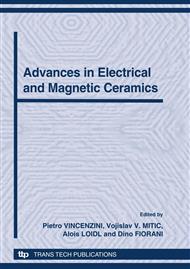p.1
p.10
p.16
p.22
p.28
p.34
p.42
p.49
p.59
Preparation and Characterization of Dielectric Behavior of A2/3Cu3Ti4O12 (A = Nd, Sm, Gd, Dy) Ceramics
Abstract:
In this work perovskite materials A2/3Cu3Ti4O12 (where A=Nd, Sm, Gd, Dy) were synthesized by conventional solid state reaction and sintered at 1000-1100°C. X-ray diffraction analysis confirmed single-phase composition of the investigated ceramics. Dielectric properties of the samples were investigated in the temperature range from -55 to 300°C at frequencies 10 Hz – 2 MHz. Dielectric permittivities of the ceramics are very high, exceeding 105 at low frequencies and/or elevated temperatures (above 50°C) and 103 at higher frequencies and/or low temperatures. Two observed contributions to the dielectric response are attributed to semiconducting grains and more resistive grain boundaries. For Nd2/3Cu3Ti4O12 and Sm2/3Cu3Ti4O12 ceramics, the observed low- and high frequency plateaus are lower than those for Gd2/3Cu3Ti4O12 and Dy2/3Cu3Ti4O12. The relaxation times determined on the basis of impedance data were found to decrease with increasing atomic number of lanthanide. The analysis of the impedance spectroscopic data and the microstructure implies spontaneous formation of internal barrier layer capacitors in the investigated materials.
Info:
Periodical:
Pages:
28-33
Citation:
Online since:
October 2010
Authors:
Price:
Сopyright:
© 2010 Trans Tech Publications Ltd. All Rights Reserved
Share:
Citation:


